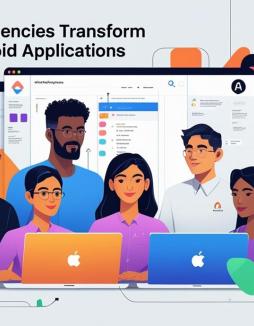Logistics App Development - Types and Development Strategy
Technology has brought about a new era of efficiency and ease in the ever-changing field of logistics, particularly in the form of Logistics App Development. This blog analyzes the many uses of logistics and the strategic methods that went into developing them. The advent of on-demand logistics app development solutions has changed the game as companies depend more and more on smooth supply chain management. We explore the fundamentals of logistics app development in this talk, illuminating the different kinds that address certain sector requirements and highlighting the role that on-demand logistics app solutions will play in forming the future of effective and adaptable supply chain networks.
Future of Logistics Apps
The global logistics app industry is booming, hitting $27.61B in 2022. Predicted surge to $149.37B by 2031, driven by e-commerce and demand for transparent supply chains.
Logistics apps have become indispensable for all supply chain stakeholders. They streamline operations, enhance visibility, and boost efficiency, benefiting manufacturers, shippers, carriers, and consumers alike. In an era of heightened expectations for transparency and speed, these apps serve as vital tools for managing, tracking, and optimizing the flow of goods, contributing to the success and competitiveness of businesses across the globe. Shippers use them to monitor their shipments, control inventory levels, and obtain affordable shipping rates from vendors. They are necessary for carriers to create effective delivery timetables, optimize routes, and maintain constant supervision over their drivers. These software are used by freight forwarding businesses to monitor and arrange shipments and provide real-time status information. Additionally, as a customer, almost everyone may.
This has led to competition between many organizations in this space to develop the greatest app feature after feature.
Looking ahead, the world of logistics applications is bright, and it won't be ending any time soon. Many elements are propelling its growth into an extremely tall structure. The first is the unexpected increase in online sales. Globally, people find that purchasing online is far more convenient than going out. They anticipate hassle-free and quick delivery of their goods as a result.
There is also the supply chain to consider. An optimized business is the key to every successful one. Logistics applications streamline processes and offer transparency. Resulting in lower expenses and more client satisfaction. Last but not least, cutting-edge technologies like blockchain, AI, and IoT are all formidable contenders to produce something revolutionary in this field. And they're already making a big difference in the world of supply chains by driving the creation of cutting-edge logistics apps. The capabilities of these applications are seemingly endless.
Anticipated Trends Shaping the Logistics Apps Landscape:
- Predictive Analytics: Predictive analytics is the way of the future for logistics software. This enables them to foresee supply chain issues and provide preventive remedies. We can now stop worrying about goods being late as a result
- Blockchain Integration: Although it may seem like a major issue, blockchain is becoming more and more popular in the field of logistics software. It is employed to bolster cargo tracking's precision and security. I'll let this one speak for itself, even if I'm not really sure how it operates.
- The Soaring Advent of Drones and Autonomous Vehicles: Do you recall the days when drones were just used for fun? These days, people use it as a quicker option for delivery of products. And self-driving cars? It's also showing up in applications for logistics. What these two can do together is unknown.
It's safe to assume that the potential for logistic applications is still enormous. A potential industry that is expected to grow quickly due to the advent of e-commerce and the need for effective supply chain management.
Types Of Logistics Apps
1. Transportation Management System (TMS) Apps:
Although logistics is a challenging industry, these applications simplify it. Carriers can carefully plan, carry out, and keep an eye on their shipments with the help of TMS applications. One feature of this is the ability to track in real-time. It's common knowledge that control and sight are crucial for moving objects, and this facilitates both. Additionally, it allows for route optimization, ensuring that everything gets to its destination fast. Shippers may also obtain quotations from carriers using this software, which helps them make more cost-effective selections.
2. Fleet Management Apps:
When it comes to fleet operations, safety comes first. They thus require their software to support drivers in being responsible and safe. Drivers and vehicles may be tracked in real-time with fleet management software. They also help in planning maintenance schedules and assigning duties. These two aid in maintaining cars in excellent condition.
3. Warehouse Management System (WMS) Apps:
There are already a lot of moving pieces in warehouses. WMS apps enter the picture by providing operational and inventory assistance. It aids in keeping inventory levels under control so that the list is tracked effectively. Additionally, the software helps with crucial tasks like packaging and selecting, which results in more efficient operations.
4. On-Demand Logistics Apps:
There are occasions when you have to send something out right away with little preparation or warning. Applications for on-demand logistics serve as a link between consumers with requirements at home and companies that can provide them quickly. Not only does it allow last-minute delivery reservations, but it also offers an easy-to-use electronic payment processing platform.
5. Last-Mile Delivery Apps:
Last-mile delivery applications aim to alleviate your concerns about shipments not arriving safely by giving customers direct access to real-time tracking information. In order to minimize transit time and maximize efficiency, it even contains optimization tools for several destinations.
6. Consumer Logistics Apps:
Want an easy way to find where your package is? Consumer logistics apps bring the convenience of tracking orders and accessing estimated delivery times. It even lets you reschedule stuff at your convenience. Return and exchanges are also made simple through these apps, making the lives of both customers and the business easier.
Things To Remember Before Having a Logistics App Development
Before you start developing a logistics app, there are several important things to consider. Here's a checklist to help you remember:
-
Make A Strategy:
Make sure that your app aligns with your business's strategy. Consider what you're trying to achieve. Whether it's optimizing your supply chain or improving customer service, the app should directly support and contribute to your goals.
-
Check The Market:
Start by doing thorough research on the demand for your app in the market. See if any competitors are making it already and what they're offering. Then, look for gaps where you can provide unique value.
-
Benefit-Cost Analysis:
Development expenses may include developer fees, design costs, server hosting, software licenses, quality assurance testing, project management, marketing, ongoing maintenance, and user support. Ensure a comprehensive budget to cover all aspects of app development. Then, write all of the potential benefits, such as reducing operational costs and increasing revenue. This will help you assess how much it will cost.
-
Secure Your Data:
Protecting data is critical when it comes to logistics apps. You contain sensitive shipment information, customer info, and financial transactions. Ensure that the app is designed to protect data from breaches and comply with relevant privacy regulations.
-
User Experience and Accessibility:
Place strong emphasis on the user experience. The app needs to be friendly, intuitive, and accessible to everyone who uses it. That includes employees, customers, and partners. A well-designed user interface can affect satisfaction and usage.
-
Resource Allocation:
When developing an app, budget for ongoing user support, updates, and maintenance. Plan for resources and team members to prevent issues. Careful long-term budgeting and staffing are crucial for sustained success.
-
Technology Partner Selection:
Partner with an experienced logistics app developer to ensure industry best practices, save time, and minimize errors. Their expertise is invaluable for success.
-
Regulations and Compliance:
Respect the law and norms. Should you do so, they will resurface and surprise you with a bite, particularly for orders coming from abroad. Always abide by them to keep your name safe and steer clear of legal troubles.
-
Business Continuity and Risk Mitigation:
We all know that things will go wrong at some time, so make sure your strategy is prepared for everything that can happen, such as server outages or data breaches. You should include strong backup procedures in your system to ensure that data integrity and business continuity are maintained.
-
Market Expansion and Growth:
Check to see whether the app has a place with new audiences or markets. Here, scalability, adaptability, and the ability to grow the user base over time are the main objectives. It's also necessary to accommodate growing demand.
-
User Support and Training:
The application must be user-friendly. It's crucial to provide user assistance and training materials for this. We're talking support lines, FAQs, and tutorials. These aid users in swiftly picking up the necessary skills.
-
Sustainability and Green Initiatives:
If your company is environmentally conscious, figure out how to make our software ecologically friendly as well. Optimizing routes to consume less petrol is one aspect that may significantly lessen the environmental effect of logistical operations.
-
Feedback Loop:
We require user feedback and insights to identify areas for improvement. Putting in place a strong feedback mechanism will enable us to achieve that. Don't forget the analytical portion, either. It will assist in pinpointing areas in need of improvement as well as improving features and functionality all around.
-
Integration with Business Partners:
A successful business partnership is essential for any endeavor involving other companies. The same holds for your app's connection with partners in logistics ecosystems. Operations become more simplified as a result, increasing overall efficiency.
-
Adaptability and Long-Term Vision:
Build your app with longevity in mind. Stay open to new concepts during development. Flexibility adds value and ensures long-term relevance in an ever-changing landscape.
Conclusion
The tactical use of logistics app development has shown to be a revolutionary force in the rapidly changing field of logistics, where accuracy and speed are critical. The many kinds of logistics applications covered here provide specialized answers for different industry needs as companies aim for increased operational efficiency. The focus on on-demand logistics app solutions highlights the movement in the industry toward flexibility and real-time response. It is vital to match development plans with the changing demands of logistics













